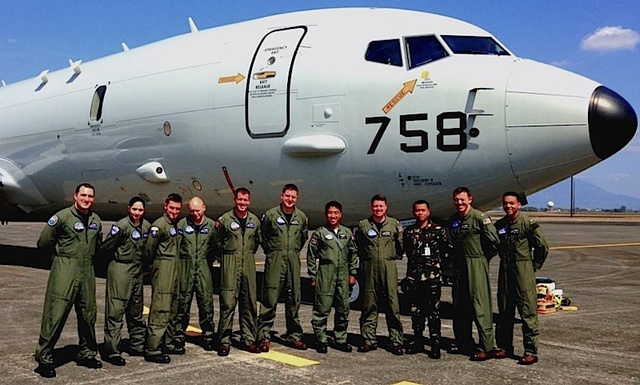The US 7th Fleet says the new P-8A aircraft is part of the Navy's commitment to the Pacific rebalance, bringing latest technology to US 7th Fleet to ensure the U.S. is best postured to honor its commitment to regional security and stability

BILATERAL PATROL
One of the United States' most advanced aircraft was in Clark Air Base in February for a temporary rotational detachment that allowed Filipino pilots to join patrol missions in the West Philippine Sea (South China Sea).
The spy plane – a long-range anti-submarine warfare, anti-surface warfare, surveillance and reconnaissance aircraft – that is under the operational control of the US Navy Patrol Squadron 45 based in Yokosuka, Japan shows the country's commitment to a strategic pivot to Asia, according to the US 7th Fleet's public affairs office.
"The new P-8A is part of the Navy's commitment to the Pacific rebalance, bringing latest technology to U.S. 7th Fleet to ensure the US is best postured to honor its commitment to regional security and stability," said the US 7th Fleet said in a statement on Wednesday, February 25.
It's a rare statement that officially acknowledged the deployment of the US spy planes that security observers have long known to be patrolling the disputed waters.
The 7th Fleet said: "The flight was a bilateral patrol mission in airspace off of Luzon Island and allowed the U.S. Navy air crew to demonstrate the P-8A's capabilities in both the littoral and open ocean environment and the flight characteristics of the P-8A in both high altitude reconnaissance missions and low altitude patrol regimes. The air crew also explained the operation of the aircraft's multi-mission sensors."

US SPY PLANE: The P-8A is the most advanced long range anti-submarine and anti-surface warfare aircraft in the world. It also provides superior maritime intelligence, surveillance and reconnaissance capability. US Navy photo
Strengthen maritime partnership
The spy plane is meant to support the fleet's mission to "to strengthen maritime partnerships in the Indo-Asia-Pacific."
The bilateral patrol mission between the US and the Philippines comes after the two countries agreed to step up joint military exercises focused on maritime security and maritime domain awareness.

BILATERAL PATROL MISSION: Pilots of the Philippine military are shown the electro-optical camera of the P-8A Poseidon. US Navy photo
The P-8A boasts of its capability to provide "superior maritime intelligence, surveillance, and reconnaissance (ISR)." It is built on the Boeing 737 airframe and is quieter than its P-3 predecessor.
They were shown how the electro-optical camera of the P-8A Poseidon works. A total of 180 flight hours were executed in its 3-week detachment in the Philippines, February 1-21.
"It was a remarkable opportunity to work alongside the members of the Filipino Armed Forces. Sharing this aircraft's capabilities with our allies only strengthens our bonds," said U.S. Navy Lt. Matthew Pool, Combat Air Crew 4 patrol plane commander.
The Philippines filed an international arbitration case against China, which claims almost all of the South China Sea. China has not been deterred, however, and has since aggressively reclaimed reefs and features in the West Philippine Sea to turn them into aritificial islands. (READ: CLOSE-UP PHOTOS: China's artificial islands in the West Philippine Sea)
One of the reclamation projects is believed to become the believed to become the site of a runway for China's air assets to be present in a disputed area already dominated by its ships. (READ: 'China to finish construction of airstrip in West PH Sea this year')
The US supports a peaceful resolution of the maritime conflict amid growing militarization in the region of the South China Sea. The US and Chinese navies have also been practicing the Code for Unplanned Encounters at Sea (CUES) that seeks to avoid confrontations and collission as the routes get busier.
Last week, littoral combat ship USS Fort Worth and the People's Liberation Army-Navy's Jiangkai II conducted routine training and operations also in the South China Sea.
http://www.rappler.com/nation/85392-american-spy-plane-philippines-pivot-asia

No comments:
Post a Comment
Note: Only a member of this blog may post a comment.